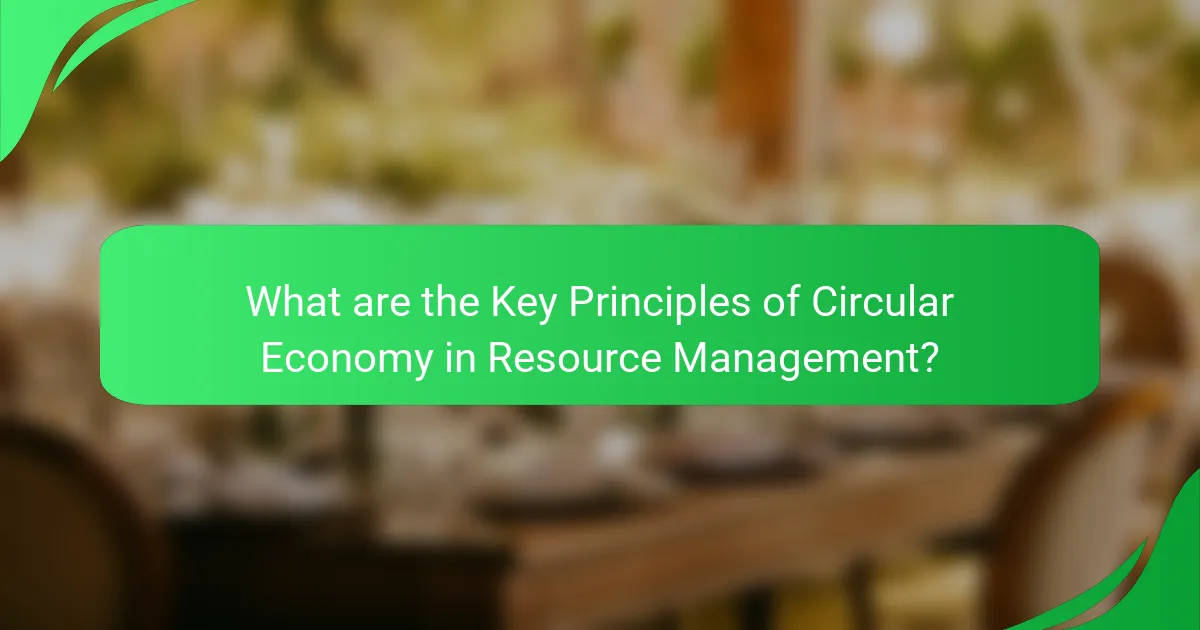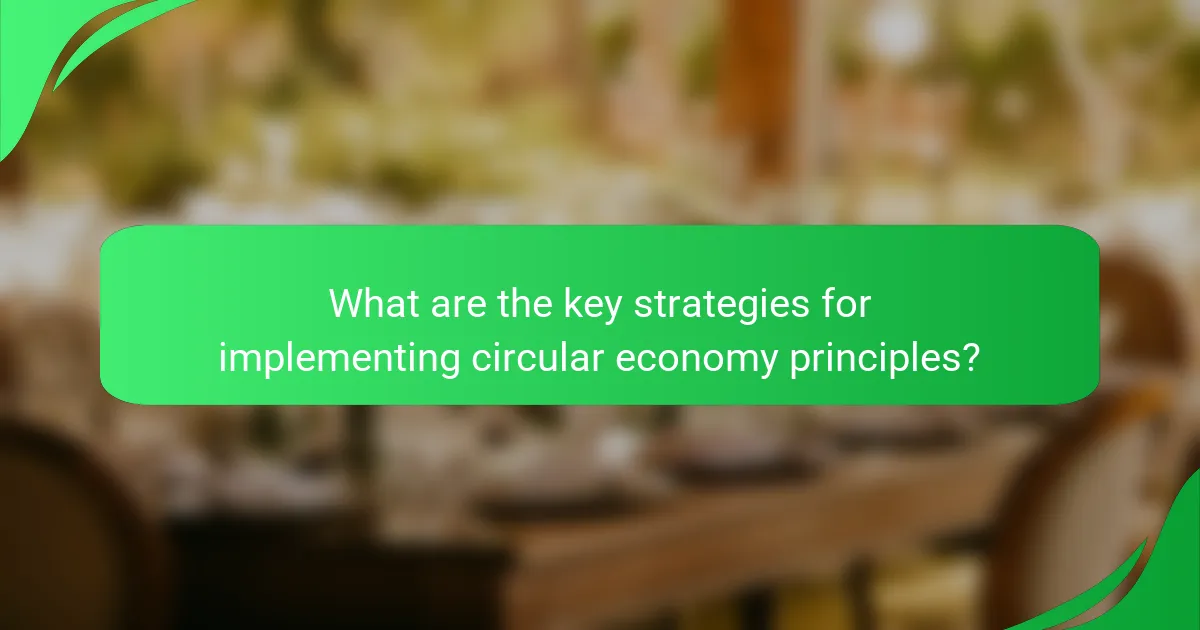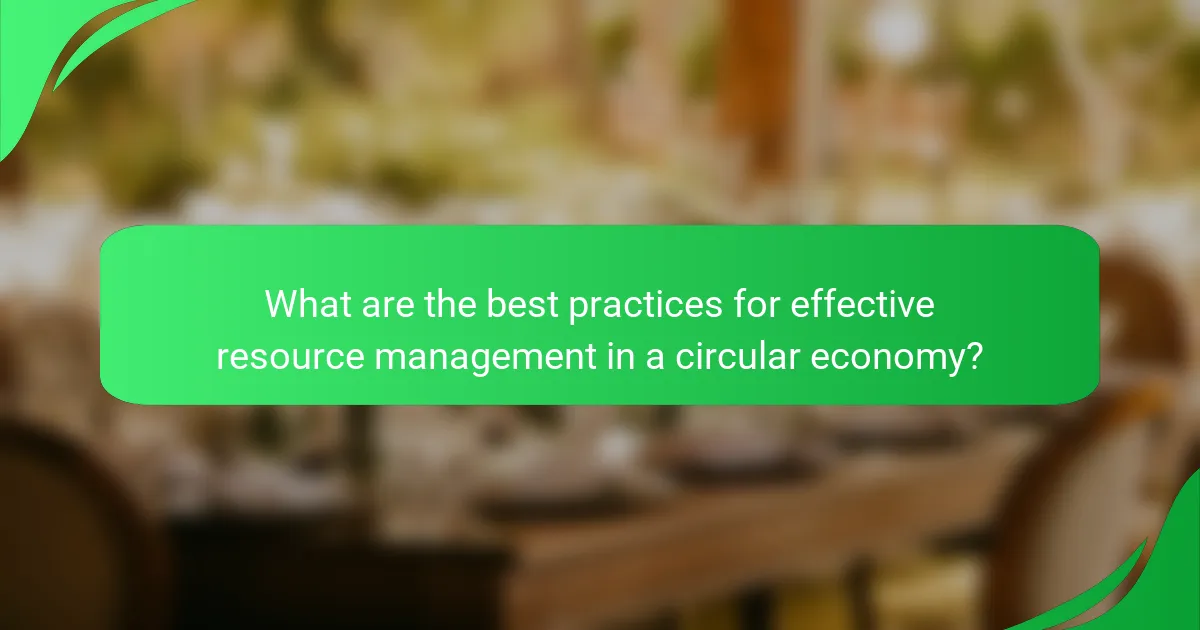The circular economy is a sustainable model focused on resource management that emphasizes waste minimization, product longevity, and resource efficiency. Key principles include designing products for durability and recyclability, implementing repair and refurbishment practices, and promoting the use of renewable resources. Effective strategies for adopting circular economy practices involve collaboration among businesses, governments, and communities, as well as enhancing product life cycles through maintenance and resource recovery. Research indicates that these practices can significantly reduce environmental impact and generate substantial economic benefits, illustrating the importance of transitioning to a circular economy for a sustainable future.

What are the Key Principles of Circular Economy in Resource Management?
The key principles of circular economy in resource management are to minimize waste, extend product life cycles, and promote resource efficiency. Waste minimization involves designing products for longevity and recyclability. Extending product life cycles includes repair, refurbishment, and remanufacturing practices. Resource efficiency focuses on using renewable resources and reducing reliance on finite materials. These principles aim to create a closed-loop system where resources are continuously reused. Research shows that implementing circular economy practices can significantly reduce environmental impact and enhance economic performance. For instance, the Ellen MacArthur Foundation highlights that transitioning to a circular economy could generate $4.5 trillion in economic benefits by 2030.
How do these principles differ from traditional linear economy models?
Circular economy principles focus on sustainability and resource efficiency, contrasting with traditional linear economy models that operate on a ‘take-make-dispose’ framework. In a linear model, resources are extracted, used, and discarded, leading to waste and depletion. Conversely, circular economy principles emphasize reuse, recycling, and regeneration of materials. This approach aims to minimize waste and maximize resource utility throughout the product lifecycle. For instance, the Ellen MacArthur Foundation highlights that circular economies can reduce resource consumption by up to 50%. Therefore, the key difference lies in the circular economy’s focus on sustainability and closed-loop systems, versus the linear model’s emphasis on one-time resource use.
What are the fundamental characteristics of a circular economy?
A circular economy is characterized by the continuous use of resources. It emphasizes reducing waste through reuse, recycling, and remanufacturing. This system aims to maintain the value of products, materials, and resources in the economy. It contrasts with the traditional linear economy, which follows a ‘take-make-dispose’ model. In a circular economy, products are designed for longevity and adaptability. Materials are kept in circulation for as long as possible. This model promotes sustainable practices and minimizes environmental impact. Research indicates that implementing circular economy principles can significantly reduce resource consumption and greenhouse gas emissions.
How does resource management play a role in these principles?
Resource management is crucial in the principles of circular economy. It ensures efficient use of resources, minimizing waste and maximizing value. Effective resource management promotes recycling, reusing, and reducing materials. This aligns with the circular economy’s goal of creating a closed-loop system. Studies show that companies implementing circular practices can reduce costs by up to 30%. Furthermore, proper resource management enhances sustainability and promotes environmental health. It encourages innovation in product design for longevity and recyclability. Overall, resource management directly supports the foundational principles of a circular economy.
Why is the circular economy important for sustainable development?
The circular economy is important for sustainable development because it promotes resource efficiency and reduces waste. This model emphasizes reusing, recycling, and regenerating materials. It helps to minimize environmental impact and conserve natural resources. According to the Ellen MacArthur Foundation, transitioning to a circular economy could lead to a reduction of up to 70% in greenhouse gas emissions. This shift supports economic growth while ensuring ecological balance. By designing products for longevity and ease of recycling, the circular economy fosters innovation and creates new job opportunities. Thus, it aligns economic activities with environmental sustainability.
What environmental benefits does the circular economy provide?
The circular economy provides significant environmental benefits by reducing waste and conserving resources. It promotes the reuse and recycling of materials, which minimizes the extraction of raw resources. This approach lowers greenhouse gas emissions associated with production and disposal. According to the Ellen MacArthur Foundation, transitioning to a circular economy could reduce global carbon emissions by 39% by 2030. Additionally, it enhances biodiversity by decreasing pollution and habitat destruction linked to resource extraction. The circular economy also encourages sustainable consumption patterns, leading to a more balanced ecosystem. Overall, these practices foster a healthier environment while supporting economic growth.
How does the circular economy contribute to economic resilience?
The circular economy contributes to economic resilience by promoting resource efficiency and reducing dependency on finite resources. It encourages the design of products for longevity, reuse, and recycling. This approach minimizes waste and lowers production costs. In turn, businesses can adapt more easily to market changes and resource scarcity. Studies show that circular practices can lead to significant cost savings. For instance, the Ellen MacArthur Foundation estimates that transitioning to a circular economy could generate $4.5 trillion in economic benefits by 2030. Additionally, circular economies can enhance job creation in repair and recycling sectors. This adaptability strengthens economies against shocks and uncertainties.

What are the key strategies for implementing circular economy principles?
Key strategies for implementing circular economy principles include designing for longevity, promoting resource recovery, and fostering collaboration. Designing for longevity means creating products that last longer and can be easily repaired. This reduces waste and conserves resources. Promoting resource recovery involves establishing systems to recycle materials back into production cycles. This minimizes the extraction of new resources. Fostering collaboration encourages partnerships among businesses, governments, and communities. Such collaboration enhances innovation and resource sharing. These strategies collectively contribute to a sustainable economic model that prioritizes environmental health and resource efficiency.
How can businesses adopt circular economy practices?
Businesses can adopt circular economy practices by implementing strategies that minimize waste and maximize resource efficiency. They can design products for longevity and reuse. Companies should focus on using sustainable materials in their production processes. Emphasizing recycling and upcycling can further reduce environmental impact. Collaborating with suppliers for a closed-loop supply chain is essential. Implementing take-back programs encourages product returns for recycling. Investing in technology that enhances resource recovery is beneficial. Training employees on circular principles fosters a culture of sustainability. These actions contribute to a more sustainable business model, aligning with the principles of circular economy.
What are some examples of successful circular economy initiatives?
Successful circular economy initiatives include the Ellen MacArthur Foundation’s projects, which promote sustainable business models. Unilever’s “Sustainable Living Plan” aims to reduce waste by using recyclable materials. Nike’s “Reuse-A-Shoe” program recycles old shoes into new products. The city of Amsterdam has implemented a circular economy strategy focusing on resource efficiency. These initiatives demonstrate how businesses and communities can reduce waste and promote sustainability effectively.
How can companies measure the impact of these practices?
Companies can measure the impact of circular economy practices through various metrics. These metrics include resource efficiency, waste reduction, and cost savings. Tracking resource efficiency can show how well materials are being utilized. Waste reduction metrics can quantify decreases in landfill contributions. Cost savings can be assessed by comparing expenses before and after implementing circular practices. Surveys and stakeholder feedback can provide qualitative insights into the perceived benefits. Additionally, companies can use life cycle assessments to evaluate environmental impacts over time. These assessments help in understanding long-term sustainability outcomes.
What role does innovation play in the circular economy?
Innovation is crucial in the circular economy as it drives the development of sustainable practices and technologies. It enables the redesign of products for longevity and recyclability. Innovative processes reduce waste and resource consumption. For instance, companies are adopting closed-loop systems to minimize environmental impact. Research indicates that businesses implementing innovative circular strategies can increase profitability by up to 30%. Furthermore, innovation fosters collaboration among stakeholders, enhancing resource sharing and efficiency. This collaborative approach accelerates the transition to a circular economy. Overall, innovation is a key enabler of sustainable resource management and economic resilience.
How can technology enhance resource management in a circular economy?
Technology can enhance resource management in a circular economy by optimizing resource use and facilitating recycling processes. Advanced data analytics allows for better tracking of resource flows. This leads to more efficient utilization and reduced waste. IoT devices monitor resource consumption in real-time. Automation in sorting and processing improves recycling rates. Blockchain technology ensures transparency in supply chains. These innovations collectively support sustainable practices. Studies show that technology can reduce resource consumption by up to 30%. This illustrates the significant impact of technological integration in circular economy initiatives.
What are the challenges of integrating innovation into circular practices?
Integrating innovation into circular practices faces several challenges. One major challenge is the lack of established frameworks for implementation. Many organizations struggle to align new innovations with existing circular economy principles. This misalignment can lead to inefficiencies and wasted resources. Another challenge is the resistance to change within organizations. Employees may be accustomed to traditional linear practices and hesitant to adopt new methods. Additionally, funding and investment in innovative circular solutions can be limited. Many businesses prioritize short-term profits over long-term sustainability. There is also a need for collaboration across sectors. Effective circular practices often require partnerships between different stakeholders. Lastly, regulatory and policy barriers can impede innovation. Inconsistent regulations can create uncertainty for businesses pursuing circular initiatives.

What are the best practices for effective resource management in a circular economy?
The best practices for effective resource management in a circular economy include designing for longevity, promoting resource recovery, and enhancing product life cycles. Designing for longevity involves creating products that last longer and are easier to repair. This reduces waste and encourages sustainable consumption. Promoting resource recovery focuses on reclaiming materials at the end of a product’s life. This can significantly decrease the demand for virgin resources. Enhancing product life cycles means implementing strategies for maintenance and refurbishment. Studies show that extending product life can reduce environmental impact by up to 30%. Additionally, engaging stakeholders in the circular economy process fosters collaboration and innovation. Overall, these practices contribute to a sustainable model that minimizes waste and optimizes resource use.
How can organizations optimize resource use and reduce waste?
Organizations can optimize resource use and reduce waste by implementing circular economy principles. These principles focus on minimizing waste through resource efficiency and sustainable practices. For example, companies can redesign products for longevity and recyclability. This approach reduces the need for raw materials and decreases waste generation. Additionally, organizations can adopt practices such as reusing materials and remanufacturing products. According to a report by the Ellen MacArthur Foundation, transitioning to a circular economy could generate $4.5 trillion in economic benefits by 2030. This demonstrates that optimizing resource use is not only environmentally beneficial but also economically advantageous.
What tools and frameworks assist in resource management?
Resource management is supported by various tools and frameworks. Key tools include project management software like Microsoft Project and Trello. These tools help in planning and tracking resources effectively. Frameworks such as Agile and Lean assist in optimizing resource allocation and minimizing waste. The Project Management Institute (PMI) provides standards and guidelines for effective resource management. Additionally, the Circular Economy Toolkit offers resources for implementing circular economy principles in resource management. These tools and frameworks facilitate efficient resource utilization and sustainable practices.
How can stakeholder collaboration enhance resource efficiency?
Stakeholder collaboration can enhance resource efficiency by pooling resources and expertise. This approach allows for shared knowledge, reducing redundancy in efforts. Collaborative strategies can lead to innovative solutions that optimize resource use. For example, joint initiatives can minimize waste and improve recycling rates. Research shows that companies engaged in partnerships report a 20% increase in resource efficiency. By aligning goals, stakeholders can create synergies that drive sustainable practices. Effective communication among stakeholders ensures that resources are allocated where they are most needed. This collective effort ultimately leads to a more sustainable circular economy.
What are common pitfalls to avoid in circular economy implementation?
Common pitfalls to avoid in circular economy implementation include insufficient stakeholder engagement. Engaging all relevant parties ensures collaboration and shared understanding. A lack of clear objectives can hinder progress. Setting measurable goals is crucial for tracking success. Neglecting to assess the lifecycle impacts of products can lead to unintended consequences. Comprehensive lifecycle assessments help identify areas for improvement. Failing to integrate circular practices into the business model can limit effectiveness. Businesses should align their strategies with circular economy principles. Underestimating the need for investment in new technologies can stall initiatives. Adequate funding is necessary for innovation and infrastructure development. Lastly, overlooking regulatory frameworks can result in compliance issues. Understanding local regulations is essential for smooth implementation.
How can organizations identify and mitigate these risks?
Organizations can identify and mitigate risks in circular economy resource management by conducting thorough risk assessments. Risk assessments involve analyzing potential environmental, social, and economic impacts. Organizations should engage stakeholders to gather diverse perspectives. Regular monitoring of resource flows can help identify inefficiencies. Implementing robust data management systems enhances risk visibility. Training employees on circular economy principles fosters a proactive risk culture. Utilizing scenario analysis prepares organizations for potential disruptions. Continuous improvement processes ensure adaptive risk management strategies.
What lessons can be learned from unsuccessful circular economy attempts?
Unsuccessful circular economy attempts reveal critical lessons for improvement. First, inadequate stakeholder engagement often leads to failure. For example, projects lacking input from local communities may not meet their needs. Second, unclear goals and metrics hinder progress. Initiatives without specific targets struggle to measure success. Third, insufficient investment in technology can limit innovation. Many projects falter without the necessary tools to implement circular practices. Fourth, overlooking consumer behavior can undermine efforts. Understanding how consumers interact with products is essential for designing effective systems. Lastly, neglecting regulatory frameworks can create barriers. Successful circular economies often align with existing policies. These lessons emphasize the importance of collaboration, clear objectives, consumer insights, and supportive regulations in circular economy initiatives.
What practical steps can organizations take to transition to a circular economy?
Organizations can transition to a circular economy by adopting specific strategies. They should first evaluate their current resource usage. This evaluation helps identify areas for improvement. Next, organizations can redesign products for longevity and recyclability. Implementing take-back schemes encourages product returns for reuse. Collaborating with suppliers can enhance resource efficiency and reduce waste. Investing in renewable energy sources minimizes environmental impact. Finally, educating employees about circular practices fosters a culture of sustainability. These steps align with the principles of reducing waste and maximizing resource use.
The main entity of this article is the circular economy, specifically in the context of resource management. The article outlines key principles such as waste minimization, extending product life cycles, and promoting resource efficiency, contrasting these with traditional linear economy models. It highlights the importance of resource management in achieving sustainability and economic resilience while detailing strategies for implementation, the role of innovation and technology, and the challenges faced. Additionally, it provides insights into successful initiatives, best practices, and practical steps organizations can take to transition to a circular economy.